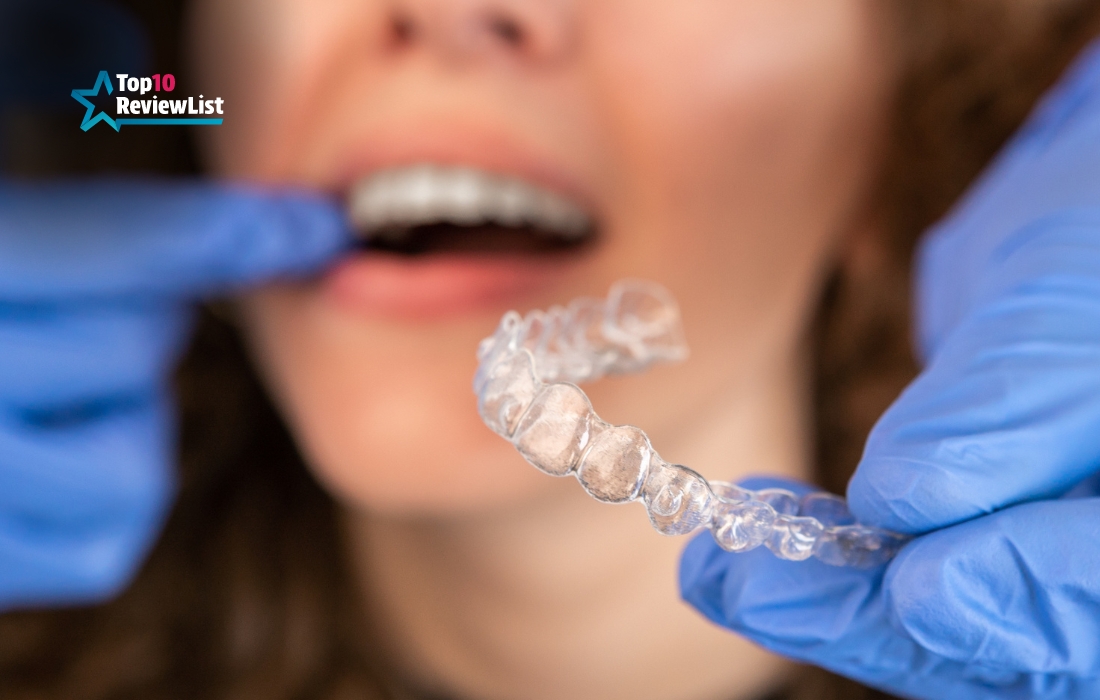If you believe achieving a flawless, aligned smile means bearing a year or more of braces, think again.
Until a few years ago, the only way to straighter teeth involved enduring expensive and uncomfortable braces. You’d grapple with metal, dietary restrictions, and frequent orthodontist appointments for wire adjustments.
However, contemporary advancements now offer simple options to attain that coveted smile. Teeth straightening kits present a sophisticated and efficient alternative to traditional braces, conveniently delivered to your doorstep.
These “invisible braces,” also known as teeth aligners, gently guide your teeth into optimal alignment, often in a fraction of the time required by traditional braces. They’re removable for eating and oral hygiene, with many brands substituting in-person orthodontist visits with virtual telehealth consultations.
In this blog, we spotlight premier brands of online invisible braces, address commonly asked questions about aligners, and aid in determining their suitability for you.
10 Best Invisible Braces and Aligners
Opting for treatment with tooth aligners through a direct-to-consumer company can also yield financial benefits compared to traditional orthodontic visits. Braces and aligners procured via orthodontic offices often carry additional costs for consumers due to markups, whereas direct-to-consumer companies bypass these markups.
When selecting a brand of invisible aligners, you have various options regarding initiation, doctor consultations, and supplementary inclusions in your kit. Here are some of the best ones
AlignerCo
They offer cost-effective enamel aligners with an online system. Their aligners use tender, BPA-free plastic, providing comfort for the duration of wear. While AlignerCo would not function as, their method specializes in affordability and accessibility, making enamel straightening convenient for all.
Starting fee: $895
Treatment duration: 6 to eleven months
Insurance attractiveness: Not specified
Pros:
- Affordable pricing as compared to many other manufacturers.
- Remote solutions are doing away with the need for frequent orthodontist visits.
- Customized remedy plans are tailor-made to the person’s wishes.
Cons:
- There are limited alternatives for in-character consultations or aid.
- Treatment may take longer in comparison to brands with multiple alternatives.
- They may or may not be appropriate for complex orthodontic cases.
Candid:
They promise customized tooth aligners fabricated from soft, BPA-free plastic. Their treatment plans prioritize individualized care and convenience, ensuring effective outcomes. While Candid doesn’t incorporate a specific vibrating device, its comprehensive technique emphasizes personalized treatment for each user.
Starting fee: $2,400
Treatment period: 6 to twelve months
Insurance acceptance: not targeted
Pros:
- Customized plans, checked by licensed orthodontists.
- Remote treatment procedures provide convenience and flexibility.
- Aligners use soft BPA-loose plastic for consolation.
Cons:
- Treatment plans can be extra luxurious in comparison to a few competitors.
- Limited in-person or female support alternatives exist for those who prefer face-to-face consultations.
- It is inappropriate for intense orthodontic cases that require sizeable intervention.
Clearbraces
It offers a comprehensive teeth straightening solution with a focus on simplicity and effectiveness. Their aligners are crafted from durable, BPA-free plastic, ensuring both comfort and durability throughout the treatment process. While Clearbraces may not include additional features like specialized vibrating devices, their commitment to clear, effective aligner solutions has made them a popular choice among users seeking discreet teeth straightening options.
Starting price: $1,799
Treatment duration: 4 to 7 months
Insurance acceptance: Not specified
Pros:
- Competitive pricing compared to other teeth aligner brands.
- Clear, discreet aligners for a seamless treatment experience.
- Aligners are made from durable, BPA-free plastic for enhanced comfort.
Cons:
- Limited information on insurance acceptance, potentially leading to uncertainty for some users.
- May not offer specialized features or devices for accelerated treatment.
- Availability of in-person support options for consultations and adjustments may vary.
SmileDirectClub:
It presents clean aligner therapy via a remote model, offering convenience and versatility. Like Candid and AlignerCo, their aligners use gentle, BPA plastic for soft wear. While SmileDirectClub doesn’t include a vibrating tool, their remote accessibility makes tooth straightening accessible to numerous users.
Starting fee: $1,950
Treatment length: 4 to six months
Insurance popularity: not distinctive
Pros:
- The remote treatment version makes teeth straightening available to a diverse customer base.
- Affordable pricing is better than traditional orthodontic treatments.
- Comprehensive aligner remedy plans tailored to customer needs.
Cons:
- There are limited individual assistance options for people who decide on face-to-face consultations.
- Treatment progress may additionally vary, and adjustments may be needed.
- Not suitable for severe orthodontic cases or complex dental troubles.
Byte:
Byte stands out for its superior technology and multiple treatment options. Their aligners, crafted from gentle, BPA-free plastic, can be worn all day or night. What sets Byte aside is the HyperByte, an FDA-cleared device that sends excessive-frequency vibrations via the teeth, helping aligner positioning and probably shortening the treatment timeline to as low as months.
Starting charge: $1,895
Treatment length: three to six months
Insurance attractiveness: not designated
Pros:
- Advanced technology, which includes HyperByte for improved treatment,.
- Customized plans.
- High-quality aligners for comfort.
Cons:
- The treatment may be extra luxurious compared to some competitors.
- They offer limited in-person or help options for people who prefer face-to-face consultations.
- These are not the right choice for cases that require expert intervention.
Invisalign:
A pioneer in the clean aligner generation offers specific and reliable teeth straightening solutions. Their aligners are built using BPA-loose plastic, making sure comfort in the course of wearing them. While Invisalign aligners do not have the characteristics of a vibrating device like the HyperByte, their enormous research and improvements have established them as a trusted leader in the orthodontic industry.
Starting charge: $3,000 to $8,000
Treatment duration: 12 to 18 months
Insurance attractiveness: Some plans may cover
Pros:
- Globally renowned for their effectiveness.
- They offer customized treatment plans.
- High-first-class aligners constitute smooth, BPA-free plastic for comfort.
Cons:
- Treatment may be more luxurious in comparison to a few competitors.
- It requires ordinary in-person visits to an orthodontist to take a look at and make adjustments.
- Not suitable for severe orthodontic instances that require considerable intervention.
Smilelove
Smilelove provides personalized teeth aligner solutions using soft, BPA-free plastic aligners. Their treatment plans cater to individual needs, prioritizing comfort and effectiveness. While Smilelove doesn’t incorporate a vibrating device like Byte, its focus on personalized care ensures a tailored approach to teeth straightening.
Starting price: $1,895
Treatment duration: 4 to 6 months
Insurance acceptance: not specified
Pros:
- Customized plans by licensed orthodontists.
- The remote treatment process offers convenience and flexibility.
- High-quality aligners consist of soft, BPA-free plastic for comfort.
Cons:
- There are limited in-person support options for those who prefer face-to-face consultations.
- Treatment progress may vary, and adjustments may be needed.
- Not suitable for severe orthodontic cases or complex dental issues.
ClearCorrect
It provides clean aligner solutions designed to align teeth. Their aligners, fabricated from tender, BPA-loose plastic, prioritize consolation at wear.
ClearCorrect aligners do not consist of a vibrating device; their commitment to clear and effective aligner solutions has made them a famous preference among customers searching for discreet teeth straightening options.
Starting charge: $2,000 to $8,000
Treatment duration: 12 to 18 months
Insurance acceptance: Some plans may additionally cover
Pros:
- Customized treatment plans overseen by licensed orthodontists.
- Discreet enamel straightening.
- These high-first-rate aligners use smooth, BPA-loose plastic for comfort.
Cons:
- Treatment may be more expensive compared to some competitors.
- There are limited individual guide alternatives for folks who opt for face-to-face consultations.
- Not suitable for excessive orthodontic instances that require sizable intervention.
Uniform Teeth
It provides clear-minded remedies with a focus on precision and effectiveness. Their aligners, crafted from smooth, BPA-unfastened plastic, ensure comfortable wear at some point in the treatment system. While Uniform Teeth Aligners do not function as a vibrating device, their dedication to unique enamel alignment contributes to successful treatment effects.
Starting price: $3,000 to $6,000
Treatment length: 6 to 365 days
Insurance popularity: not distinct
Pros:
Precision-focused treatment plans supervised by skilled orthodontists.
Clear aligners offer discreet enamel straightening.
High-pleasant aligners use BPA-unfastened plastic for consolation.
Cons:
- There are limited individual assistance alternatives for individuals who decide on face-to-face consultations.
- Treatment may be more expensive compared to a few competitors.
- Not suitable for excessive orthodontic instances or complicated dental issues.
NewSmile
The team’s focus is on affordability and convenience. NewSmilae aligners, crafted from smooth, BPA-loose plastic, ensure comfort for the duration of the put-on. While NewSmile aligners don’t encompass a vibrating tool, their dedication to affordability and accessibility makes enamel straightening a potential goal for many individuals.
Starting fee: $1,395
Treatment duration: three to six months
Insurance acceptance: NA
Pros:
- Affordable pricing as compared to many different manufacturers.
- A remote treatment procedure offers comfort and flexibility.
- Aligners are made using smooth, BPA-level plastic for comfort.
Cons:
- There are limited alternatives for in-person or female consultations or aid.
- Treatment development may vary, and changes may be needed.
- They are not appropriate for excessive orthodontic cases or complex dental troubles.
Methodology: How We Evaluate Invisible Braces
What are the types of invisible braces?
In orthodontics, there are three main categories of braces:
1. Metal braces: These are the conventional braces comprising brackets affixed to every enamel, interconnected using wires. Regular visits to an orthodontist are vital for modifications, generally every 4 to 8 weeks.
2. Clear braces: These clean braces are usually made from a transparent ceramic cloth, blending with the natural coloration of teeth. Like their steel counterparts, they necessitate routine visits to the orthodontist for preservation.
3. Teeth aligners: Alternatively known as invisible braces, these aligners encompass a sequence of plastic trays corresponding to mouthguards. They are worn over the pinnacle and backside teeth to realign them.
Teeth Aligners vs. Metal Braces
Several factors come into play while deciding between traditional braces and aligners:
1. Cosmetic enchantment: These aligners are inconspicuous and attract those searching for diffused tooth correction.
2. Cost: Traditional braces range from $5,000 to $6,000, whereas aligner remedies can range from $895 for absolutely remote options like AlignerCo to $5,000 for in-person options like Candid.
3. Severity: Aligners are suitable for moderate to slight corrections, while excessive orthodontic issues might require traditional braces.
4. Convenience: Aligners provide the freedom of ingesting and cleansing, contrasting with the constant nature of traditional braces, which demand ordinary office visits for modifications.
5. Adherence: While detachable aligners offer convenience, inconsistent use may additionally prolong the remedy period, affecting each adolescent and individual user.
How do Teeth Aligners help?
The process of tooth straightening with aligners generally spans 4 to 6 months. Initial steps include choosing between fully remote solutions or virtual and offline care. Many groups offer a preliminary screening technique to assess candidacy before committing to treatment.
Teeth Aligners: DIY Home Kits
Most reviewed companies offer domestic kits to initiate remedies. AlignerCo solely gives this option, consisting of clean commands, online resources, and customer service, to manual customers through the influence technique.
Clear Braces: In-Person Scans and Treatments
Some businesses provide the alternative of in-person 3-D scans instead of impact kits. With this approach, orthodontists seize an in-depth picture of enamel positions with a specialized software program. Regardless of the technique selected, a waiting period ensues before receiving custom-made aligners.
Upon receipt, aligners are worn for a precise duration, usually two weeks, in keeping with the pair. Users can opt for a wearing timetable of 20–22 hours per day for expedited treatment or eight–10 hours nightly for an extended period.
Post-treatment, carrying retainers at night is vital to preserving tooth alignment. Several groups include preliminary units of retainers, emphasizing their importance in maintenance.
Determining Suitability for Invisible Braces
Aligners deal with numerous dental troubles, which include spacing irregularities, overbites, and slight relapses post-orthodontic treatment. However, complex instances might also warrant traditional braces.
Companies generally provide online quizzes or direct conversation channels to evaluate suitability. In instances where aligners show incorrect information, you can opt for refunds.
How Do Teeth Aligners Work?
The aligner treatment process typically lasts 4-6 months and involves the following steps:
1. Choose a service model: Decide between fully remote or hybrid office-based care.
2. Create impressions: Use an at-home impression kit or visit a local office for a 3D scan.
3. Receive aligners: You’ll receive your custom aligners in 2-3 weeks.
4. Follow the plan: Wear each set of aligners for the specified time, usually 20–22 hours per day or 8–10 hours per night.
5. Retainers: Wear a retainer at night after treatment to maintain results.
Are invisible braces right for you?
Invisible braces can address various dental issues, such as overcrowding, widely spaced teeth, overbites, crossbites, and mild relapses. Consult a professional orthodontist to determine if aligners are appropriate for your situation.
Do invisible braces work faster?
On average, aligners yield faster results than traditional braces.
Aligners generally yield quicker outcomes as compared to traditional braces.
Metal or clear braces: average treatment duration of 1–2 years
Teeth aligners: average remedy duration of 4–8 months
Strict adherence to wearing instructions is critical for well-timed effects.
Maintaining and cleaning invisible braces
Proper upkeep guarantees aligners remain workable and hygienic. Each organization offers suggestions for cleaning, frequently related to a brief soaking in cleansing solutions like vinegar or soap, accompanied by a thorough rinsing. Specialized cleaning gadgets also help to keep them functional in the long run.
Conclusion:
Invisible braces offer a discreet and convenient solution for various dental issues. By understanding their benefits, limitations, and proper usage, you can decide if aligners are the right choice.
FAQs
How do invisible braces straighten teeth, and what is the typical duration of treatment?
Invisible braces apply gentle pressure to teeth, guiding them into proper alignment over 4 to 8 months.
What are the benefits of choosing invisible braces over traditional braces?
Invisible braces offer enhanced aesthetics, are less noticeable, and are removable for eating and oral hygiene. They often require fewer orthodontist appointments.
Are there any dietary restrictions when using invisible braces?
While there are generally no strict restrictions, removing aligners before consuming foods or beverages that may stain or damage them is a great move.
How often are orthodontist appointments required when using invisible braces?
Orthodontist appointments for invisible braces are typically less frequent, usually every 4 to 8 weeks for checking and adjustments.
Can invisible braces be removed for eating and oral hygiene?
Yes, invisible braces are easily removable for eating and oral hygiene, providing greater convenience during treatment.




